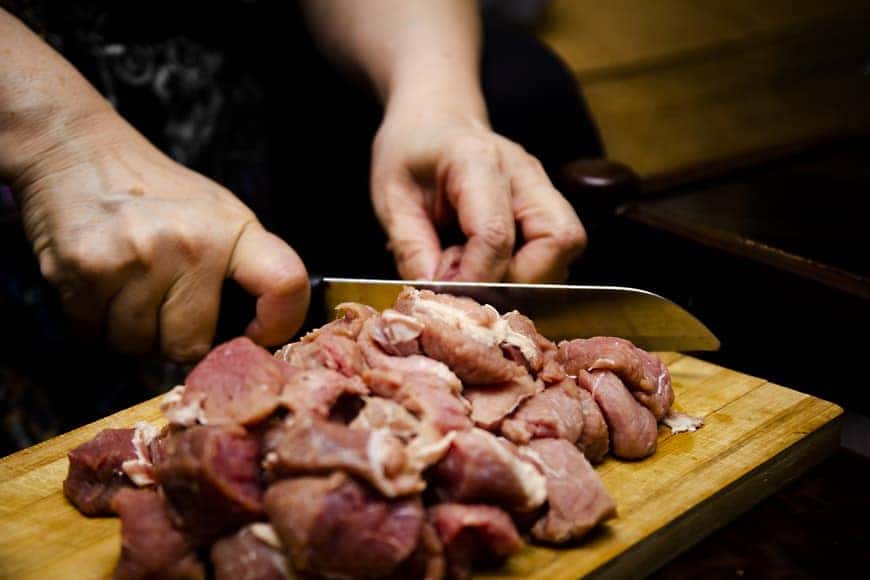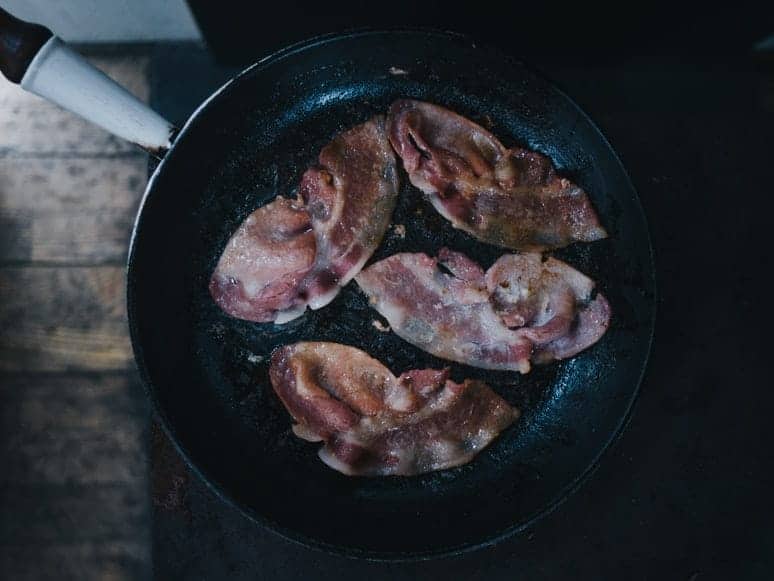Fatback is a solid fat slab found in the back of the pig. It looks similar to a slice of bacon but without any meat. It is delicious on its own but tastes divine with seasonings of sea salt and some herbs. It is also a potent flavoring ingredient in other dishes.
Pork fatback is rare at grocery stores, but you can get it at butcheries. It is considered hard fat, while fats from other parts of its body are soft fat.
Not many people are aware of its cooking procedure. However, if you have recently come across fatback or have tasted it somewhere and want to cook it yourself, we’ll teach you how.
There are different ways of preparing pork fatback; keep reading to find them out. But before that, let’s learn a few more things about this delicacy…
Pork Fatback: Here is a Quick Glance

Only found in mature pigs, fatback comes under the skin of the back with or without skin. Many European cultures use fatback to make bacon; it’s their special delicacy.
Earlier, people in Italy used fatback as their staple cooking fat, primarily in regions where oil trees were sparse. Fatback is a classic ingredient in Battuto, a traditional dish of sauteed vegetables and herbs.
Fatback has different names in different countries. People in Italy call it Lardo, Russian people call it Salo, whereas people in Hungary call it Szalonna. These are just a few examples. Fatback is prevalent in many other countries, and people know it with different names.
Irrespective of its name, people enjoy eating pork fatback in different parts of the globe, and it’s a central part of different cuisines.
How to Cook Fatback?

Have you recently tasted fatback in a restaurant? Do you want to make it at home? Here is the recipe for it. We will tell you how to make delicious fatback while preserving authentic European flavors.
You can add fatback to almost any dish involving sausages, meatballs, meatloaf, or grounded meat. It adds moisture and juiciness to the dish apart from adding a unique flavor.
We will talk about fatback as an ingredient in different dishes and how to use it. But first, let’s have a look at the signature style of cooking fastback:
- If you have a thick slab of fatback, first cut it into small slices.
- If you want to reduce the salty taste, you can boil it before cooking it. However, people who love it with its original salty flavor may avoid the boiling part.
- Take a pan or skillet put it on medium flame.
- Now put the fatback into the pan. It is already high in fat content, so you don’t have to add any oil or greasing.
- Cook on both sides for about 3 minutes each.
- It will darken, and the edges will curl up; that’s when you know the fatback is ready.
- Turn off the flame and place the fatback in a paper towel to absorb extra oil.
Cooking Fatback in the Oven
You can cook fatback in the oven as well. Here is how you can utilize your oven for cooking fastback:
- Preheat the oven at 375° F
- Season the fatback on both sides. Again, you can use your favorite herbs. Fatback is already salty, so you don’t have to season it with extra salt.
- Now place the slices on a baking pan, leaving space in between. You can use aluminum foil to line the pan. It makes cleaning the pan easy.
- Place the baking pan inside the oven and cook for about fifteen minutes. It should turn slightly brown and crispy.
- Your pork fatbacks are ready to serve now!
These are the signature ways of cooking fatback. But there are few other ways to use it as an add-on or flavoring ingredient in other dishes. So let’s take a look at them as well:
- Turkey or chicken breast, pork loin, etc., are pretty low in fat to be less juicy and less flavorful. So adding fatback in such dishes is a great way to add moisture and boost the taste.
- If you are roasting turkey, chicken, or pork loin, you can insert some fatback stripes inside the meat. As the meat cooks, the fatback inside will melt and enhance the meat’s flavor, making the meat juicier.
- Putting the pork fatback inside the meat is known as larding. There is another technique called barding when slices of fatback are wrapped over the piece of meat.
- Another way of using fatback is adding sausages, ground meat, burgers, meatloaf, meatballs, etc. In addition, you can add fatback to ground meat sauteed vegetables as a flavoring ingredient.
But be careful while adding fatback to burgers or meatloaf. As fatback has a high moisture content, it may shrink meat in such items if you put too much fatback.
Fatback Varieties

Fatback comes with a few variations as well. Let’s have a look and find out about them:
- Salt Pork
This type of fatback is salted to prolong its shelf life. It is a dominant ingredient in many Southern dishes adding juiciness and flavor to the meals.
- Streaky Pork
It is a section of fat in between the bacon at the belly and hard fatback near the backbone. Streak pork has a layer of meat running through the fat, whereas the original fatback has no meat.
- Lardo
It is Italian salumi made using fatback, herbs like rosemary, wild fennel, oregano, garlic, and other seasonings. Lardon can last up to six months which people eat as an appetizer or spread with bread.
Does Fatback Expire?
Fatback is a flavoring ingredient and also is eaten as it is. Considering the various ways we can use fatback, it’s important to know if it can go bad. Or for how long you can preserve fatback.
The most common question people ask about fatback is if it goes wrong. Yes, it does but only the raw variant. Cooked fatbacks have a longer shelf life compared to uncooked ones.
Raw fatback lasts for three days up to a week in the refrigerator. However, there are disagreements among people regarding this.
Some say it stays fresh for up to a week in the refrigerator, whereas some others say it stays good just for three to four days. But we would suggest you use raw fatback within three to four days.
But you can store raw fatback for up to six months when stored in the freezer. If you keep it in a well-packed condition, your pork fatback won’t go rancid.
The best way to store fatback is in its actual vac-pack as long as you don’t break the seal. If you are using your Ziploc bag, make sure there is no air inside the package. You should squeeze out the air before transferring it into the freezer.
If you keep it in a loosely packed package, it will develop a confinement odor, which is not pleasing.
Final Lines on How to Cook Fatback
Cooking fatback is quite simple and easy. It does not require any other ingredient to cook if you have it, like bacon.
Adding it in other dishes helps enhance the taste-making the recipes juicer and tastier. So give fatback a try if you haven’t yet, and check out the recipes we mentioned.
More Posts for You:
